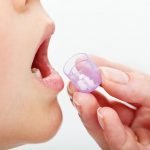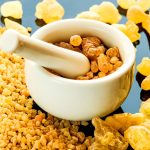Molecular Hydrogen & Bile Acids: Novel Therapies for Autoimmune Disease?
Vis Medicatrix Naturae
Carrie Decker, ND
Any practitioner that has seen more than a handful of autoimmune disease cases knows how challenging their management can be. The laundry list of potential contributing factors to consider is long, including gastrointestinal pathogens, chronic viral infections, heavy metal toxicity, and food antigenic triggers. Unfortunately, even with resolution of such issues, the autoimmune patient often hovers on the brink of having a flare, which can be provoked by such common events as stress, antibiotic use, or re-exposure to any of the contributing factors just listed.
Fortunately, as integrative practitioners, we have available a deep toolkit of interventions. From utilizing treatments aimed at resolving the possible pathoetiologies indicated by testing, to addressing problematic single nucleotide polymorphisms, we typically support the wellness of our patients holistically using measures such as nutrition, antioxidants, anti-inflammatories, probiotics, homeopathy, needling, and physiotherapy.
But even with this deep toolkit, we each may wonder at times, particularly with our most difficult autoimmune cases, “Is there something more I could try?” Well, the answer is yes (there always is), but often we don’t have the time to go down the proverbial wormhole to research the data supporting less common supplement interventions. Instead, we elect to use the tools we know best. Herein, we take a look at 2 lesser-known interventions – molecular hydrogen and bile acids – which are backed by a surprising amount of recent and ongoing research pertaining to their impact on autoimmune disease.
Molecular Hydrogen
Although already in use in the 1940s to help prevent decompression sickness in divers,1,2 hydrogen (H2) wasn’t practically useful as a therapy for several decades due to its high flammability. In 2007, promising research, published in Nature Medicine,3 used H2 in a format that was finally clinically practical (ie, in air at a concentration below the flammability threshold or dissolved in a cellular nutrient medium). After this, the research exploded.
Since 2007, H2 has been administered in clinical studies as an inhaled gas,4 dissolved in water for oral delivery or topical application,5,6 or delivered in saline intravenously.7 Because of its size, neutral charge, nonreactivity, and nonpolarity, H2 readily passes through membranes (eg, cellular membranes and the blood-brain barrier) and flows into all cellular compartments and biological tissues. This is evidenced in part by its rapid appearance in the expired air from the lungs after oral intake or intravenous delivery of H2, with levels peaking within 5 to 15 minutes.8 However, its biological effects are not limited to the time it remains in circulation, as suggested by multiple studies, including in the clinical setting of rheumatoid arthritis.9,10,11
H2 primarily reacts with highly reactive and toxic oxidants (such as the hydroxyl radical [•OH] and peroxynitrite [ONOO-]), leaving weaker (and biologically necessary) oxidants like nitric oxide (NO) and hydrogen peroxide (H2O2) present.12 That said, it does reduce overproduction of these oxidants as well as proinflammatory cytokines triggered in highly “stressed” states (such as ischemia/reperfusion injury or lipopolysaccharide stimulation),13–15 including interleukin (IL)-6, IL-1β, and tumor necrosis factor-alpha (TNFα).16–18 In addition to reducing •OH and ONOO- radicals, H2 activates the nuclear factor erythroid 2-related factor (Nrf2)-antioxidant response element (ARE) pathway,19 turning on the transcription of antioxidant elements, detoxification enzymes, and proteins required for glutathione synthesis and recycling.20
H2 & Rheumatoid Arthritis
Multiple clinical studies have shown that supplementation with H2 may benefit individuals with autoimmune disease. The first publication of this nature was an open-label pilot study that investigated the impact of consumption of supersaturated H2 water on patients with rheumatoid arthritis (RA).21 As levels of the •OH radical have been shown to be associated with a higher level of disease activity and its associated damage,22 it is highly plausible that H2, an excellent •OH scavenger, might be of benefit to patients with RA.
In this pilot study, participants consumed 530 mL of H2-rich water (containing 4-5 ppm of H2) daily for 4 weeks, then had a 4-week washout, followed by another 4 weeks of H2 water consumption.21 Of the 20 patients in the study, 5 of them had early RA (duration of less than 12 months), and 4 of them were not on any medication. The other participants were either on methotrexate or abatacept, a combination of these, or no medications (abandoned due to side effects). No one in the study was being treated with steroid hormones.
During each period of treatment with the H2-rich water, RA disease activity scores, based on assessment of 28 joints (DAS28), improved. In the first 4 weeks, scores decreased in 18 of the 20 patients. By the end of the study, the average DAS28 score for all participants had decreased from the baseline of 3.83 to 2.26, and the 5 patients having early RA all achieved remission (defined for the purpose of this study as a DAS28 <2.3, although a cutoff value of 2.6 is often used23), with 4 of them becoming symptom-free.21
One particularly interesting finding of this study was that the DAS28 score continued to improve during the 4-week washout period, suggesting that the H2 treatment continued to have residual effects. Levels of urinary 8-hydroxy-deoxyguanosine (8-OHdG), a marker of DNA oxidative damage,24 also improved, not only during treatment but also during the washout phase, remaining below the baseline through the end of the study.21 It has been suggested that some of the longer-term effects seen with H2 as a therapy are due to its impact on cellular signal transduction, protein activity, and genetic transcription, as its direct antioxidant effects would be limited to its time in circulation.8
Prolonged benefits with hydrogen treatment were also seen in a follow-up randomized, double-blind, placebo-controlled study of RA patients, in which the impact of 5 days of treatment with 500 mL of intravenous, H2-enhanced saline was examined.10 In this study, the DAS28 score in the H2-treated group decreased from the baseline of 5.18 to 4.02 immediately after infusions, and to 3.74 by 4 weeks, whereas there was no change in the score of the placebo group. Additionally, the level of IL-6 and matrix metalloproteinase-3, markers of inflammation and joint damage,25 decreased significantly in the H2-treated group, while they increased in the placebo group.
Other Applications
A publication of 3 psoriasis case studies using a variety of H2 administration techniques (inhalation, intravenous, and taken orally in water) reported improvements in skin lesions and psoriatic arthritis symptoms regardless of the route of intervention.26 Bathing in H2-rich water has also been studied as a treatment for psoriasis, and resulted in an improvement of 75% or more in the Psoriasis Area Severity Index (PASI) score in 10 of 41 of patients after 8 weeks, while only 1 of 34 patients in the control group experienced the same level of improvement.5 Although a whole-body bath may not be practical for most people, soaking a portion of the body that is affected with psoriasis lesions in H2-rich water is not tremendously difficult, thus worthy of consideration.
The antioxidant principles and other biological effects of H2 broadly translate to numerous potential health benefits – so many, in fact, that over 450 publications reflecting more than 170 different human and animal disease models exist.27,28 From human research, we have seen that H2 may also improve outcomes in post-acute cerebral infarction,4 Parkinson’s disease,29 adverse effects of radiation treatment,30 metabolic health,31 fatty liver disease,32 exercise performance,33 autonomic nervous system balance,34 and periodontal disease,35 among other areas,36 clearly making it a therapy to continue to follow as research rapidly advances.
Bile Acids
The therapeutic use of bile dates back to ancient times. Bile from many different animals, and even humans in the time of battle, has a record of medicinal use in traditional Chinese medicine (TCM) beginning in the Zhou dynasty, from 1046-256 BCE.37 In TCM, bile acids are used for the treatment of gallstones, infectious skin diseases or burns, vision and eye conditions, respiratory infections, and even coma and epilepsy.38
Generally, when we think of bile, we primarily think of the role it plays in the digestion and absorption of dietary fats and fat-soluble vitamins. However, modern medicine is beginning to recognize the role played by bile acids, not only in the digestive tract, but also as regulators of metabolism, inflammation, detoxification, and even neurological function.38–40 Given that bile acids serve as signaling molecules and activate receptors found in nearly every part of the body, including the vitamin D receptor,41 we probably should not find it surprising that they also are being investigated as agents to help regulate the immune response.
The human bile salt pool is primarily comprised of cholic acid (CA), chenodeoxycholic acid (CDCA), and deoxycholic acid (DCA), with smaller amounts of lithocholic acid (LCA) and ursodeoxycholic acid (UDCA).42,43 In the hepatocyte, the bile acids CA and CDCA are conjugated by the addition of glycine or taurine (increasing their water solubility) before they are transported into the bile canaliculus. In the gut, deconjugation and dehydroxylation by gut microbial enzymes lead to the formation of the secondary bile acids DCA (from CA) and LCA (from CDCA).44 Ox bile, one of the first forms of bile to be used in TCM, contains many of the same bile acids found in human bile, primarily comprised of CA, with modest amounts of DCA and CDCA.37,45
Deconjugated bile acids are not only more hydrophobic, they also have stronger antimicrobial action, in part due to their ability to break down bacterial membranes.46 Bile acids also have indirect antimicrobial effects by binding with farnesoid X receptor (FXR), which induces the secretion of antimicrobial peptides.47 Lower levels of bile acids in the gut are associated with an overgrowth of bacteria and potential pathogens (eg, Clostridium difficile48 and Helicobacter pylori49), increased inflammation, and increased bacterial translocation.50 FXR agonism also has been shown to support intestinal barrier integrity and reduce bacterial translocation.51
Bile Acids & IBD
Perhaps not surprisingly, given their diverse actions in the gut, one condition of autoimmunity in which bile acids may play a role is inflammatory bowel disease (IBD). In addition to their effects on the gut directly, bile acids may impact IBD through interactions with the innate and adaptive immune system, as receptors that bile acids bind (FXR and the G-protein-coupled bile acid receptor, Gpbar1 [TGR5]) are expressed by cells of the immune system (including macrophages, dendritic cells, and natural killer T-cells) and serve to help maintain immune tolerance.52 Bile acids also stimulate hepatocyte phosphatidylcholine secretion,53 an important component of the protective intestinal mucosal barrier,54 which has been shown to be deficient (and therapeutic when applied as a treatment) in patients with ulcerative colitis.55,56
Patients with IBD have been shown to have lower levels (especially during a flare) of the secondary bile acids,57 which have strong antimicrobial effects. Animal and cellular studies of IBD point towards the therapeutic effect bile acids may have in this condition, finding that FXR activation reduced goblet cell loss and inflammation and improved intestinal permeability and colitis symptoms.58 In patients with Crohn’s colitis, a reduced level of FXR activation in the ileum has been observed.59 Supplementation of CDCA, the bile acid having the greatest affinity for FXR,60 at a dose of 15 mg/kg/day to patients in remission from Crohn’s, was shown to increase ileal FXR target gene expression as well as gallbladder filling.61
Interactions of bile acids with TGR5 also may affect individuals with IBD by many different mechanisms. Multiple animal models show that the absence or lowered expression of TGR5 leads to increased inflammation, or that the stimulation of TGR5 with bile acids helps ameliorate it.62,63 Elimination of TGR5 expression in animals leads to abnormal colonic mucous cell morphology, increased intestinal permeability, and an increased susceptibility to colitis.64 Conversely, treatment with DCA and LCA, the bile acids that most strongly activate TGR5,62 suppresses the release of proinflammatory mediators from lamina propria mononuclear cells isolated from inflamed tissue of Crohn’s patients.65
Individuals with IBD also have been shown to have lower levels of bacteria in the gut that deconjugate bile acids.57 For this reason, probiotics that deconjugate bile acids (in particular those that express bile salt hydrolase [BSH], known as BSH-active bacteria) also have been suggested as a therapy for IBD. Notably, in a study of adults with digestive symptoms and hypercholesterolemia (another condition for which BSH-active probiotics are being investigated), the BSH-active probiotic Lactobacillus reuteri NCIMB 30242 not only significantly increased plasma levels of deconjugated bile acids, but also improved digestive symptoms, particularly that of diarrhea, and reduced inflammation, as assessed by high-sensitivity C-reactive protein.66,67
Other Applications
IBD is not the only condition of autoimmunity or immune dysregulation for which bile acids are being investigated as a potential therapy. Treatment of mice with CDCA or obeticholic acid, a synthetic variant of CDCA that has considerably higher binding affinity for FXR, was shown to improve experimental autoimmune encephalomyelitis, modulating immune system activation and reducing proinflammatory cytokine production.68 Clinically, treatment with bile acids has been shown to improve psoriasis,69 suggested to be mediated by the effects of bile acids on the gut flora balance and reduction of intestinal permeability and endotoxin-induced inflammation.70 Multiple animal and cellular studies also show bile acids may decrease the allergic response, inhibiting IgE production71 and reducing the allergen-induced airway response (including production of inflammatory cytokines, mucus metaplasia, and airway hyperresponsiveness).72,73
Conclusion
Clearly, both H2 and bile acids are intriguing therapies, not only for inflammatory disorders such as autoimmune disease, but also a wide variety of other clinical conditions. In addition to our commonly used antioxidants and probiotics used to address the inflammation, oxidative stress, and dysbiosis common to these conditions, perhaps H2 and bile acids should receive further consideration as interventions in our integrative toolkit.
References:
- Bjurstedt H, Severin G. The prevention of decompression sickness and nitrogen narcosis by the use of hydrogen as a substitute for nitrogen (the Arne Zetterstrôm method for deep-sea diving). Mil Surg. 1948;103(2):107-116.
- Dougherty JJ Jr. Use of H2 as an inert gas during diving: pulmonary function during H2-O2 breathing at 7.06 ATA. Aviat Space Environ Med. 1976;47(6):618-626.
- Ohsawa I, Ishikawa M, Takahashi K, et al. Hydrogen acts as a therapeutic antioxidant by selectively reducing cytotoxic oxygen radicals. Nat Med. 2007;13(6):688-694.
- Ono H, Nishijima Y, Ohta S, et al. Hydrogen gas inhalation treatment in acute cerebral infarction: a randomized controlled clinical study on safety and neuroprotection. J Stroke Cerebrovasc Dis. 2017;26(11):2587-2594.
- Zhu Q, Wu Y, Li Y, et al. Positive effects of hydrogen-water bathing in patients of psoriasis and parapsoriasis en plaques. Sci Rep. 2018;8(1):8051.
- Kajiyama S, Hasegawa G, Asano M, et al. Supplementation of hydrogen-rich water improves lipid and glucose metabolism in patients with type 2 diabetes or impaired glucose tolerance. Nutr Res. 2008;28(3):137-143.
- Kurokawa R, Seo T, Sato B, et al. Convenient methods for ingestion of molecular hydrogen: drinking, injection, and inhalation. Med Gas Res. 2015;5:13.
- Qian L, Shen J, Sun X. Methods of Hydrogen Application. In: Sun X, Ohta S, Nakao S, eds. Hydrogen Molecular Biology and Medicine. Dordrecht, Netherlands: Springer; 2015.
- Gu H, Yang M, Zhao X, et al. Pretreatment with hydrogen-rich saline reduces the damage caused by glycerol-induced rhabdomyolysis and acute kidney injury in rats. J Surg Res. 2014;188(1):243-249.
- Ishibashi T, Sato B, Shibata S, et al. Therapeutic efficacy of infused molecular hydrogen in saline on rheumatoid arthritis: a randomized, double-blind, placebo-controlled pilot study. Int Immunopharmacol. 2014;21(2):468-473.
- Hara F, Tatebe J, Watanabe I, et al. Molecular Hydrogen Alleviates Cellular Senescence in Endothelial Cells. Circ J. 2016;80(9):2037-2046.
- Matei N, Camara R, Zhang JH. Emerging mechanisms and novel applications of hydrogen gas therapy. Med Gas Res. 2018;8(3):98-102.
- Ohta S. Molecular hydrogen as a novel antioxidant: overview of the advantages of hydrogen for medical applications. Methods Enzymol. 2015;555:289-317.
- Sakai T, Kurokawa R, Hirano SI, Imai J. Hydrogen Indirectly Suppresses Increases in Hydrogen Peroxide in Cytoplasmic Hydroxyl Radical-Induced Cells and Suppresses Cellular Senescence. Int J Mol Sci. 2019;20(2). pii: E456. doi: 10.3390/ijms20020456.
- Itoh T, Hamada N, Terazawa R, et al. Molecular hydrogen inhibits lipopolysaccharide/interferon γ-induced nitric oxide production through modulation of signal transduction in macrophages. Biochem Biophys Res Commun. 2011;411(1):143-149.
- Xie K, Yu Y, Huang Y, et al. Molecular hydrogen ameliorates lipopolysaccharide-induced acute lung injury in mice through reducing inflammation and apoptosis. Shock. 2012;37(5):548-555.
- Ren JD, Wu XB, Jiang R, et al. Molecular hydrogen inhibits lipopolysaccharide-triggered NLRP3 inflammasome activation in macrophages by targeting the mitochondrial reactive oxygen species. Biochim Biophys Acta. 2016;1863(1):50-55.
- Zheng X, Mao Y, Cai J, et al. Hydrogen-rich saline protects against intestinal ischemia/reperfusion injury in rats. Free Radic Res. 2009;43(5):478-484.
- Yu J, Zhang W, Zhang R, et al. Molecular hydrogen attenuates hypoxia/reoxygenation injury of intrahepatic cholangiocytes by activating Nrf2 expression. Toxicol Lett. 2015;238(3):11-19.
- Buendia I, Michalska P, Navarro E, et al. Nrf2-ARE pathway: An emerging target against oxidative stress and neuroinflammation in neurodegenerative diseases. Pharmacol Ther. 2016;157:84-104.
- Ishibashi T, Sato B, Rikitake M, et al. Consumption of water containing a high concentration of molecular hydrogen reduces oxidative stress and disease activity in patients with rheumatoid arthritis: an open-label pilot study. Med Gas Res. 2012;2(1):27.
- Khojah HM, Ahmed S, Abdel-Rahman MS, Hamza AB. Reactive oxygen and nitrogen species in patients with rheumatoid arthritis as potential biomarkers for disease activity and the role of antioxidants. Free Radic Biol Med. 2016;97:285-291.
- Mäkinen H, Hannonen P, Sokka T. Definitions of remission for rheumatoid arthritis and review of selected clinical cohorts and randomised clinical trials for the rate of remission. Clin Exp Rheumatol. 2006;24(6 Suppl 43):S-22-8.
- Wu LL, Chiou CC, Chang PY, Wu JT. Urinary 8-OHdG: a marker of oxidative stress to DNA and a risk factor for cancer, atherosclerosis and diabetics. Clin Chim Acta. 2004;339(1-2):1-9.
- Yamanaka H, Matsuda Y, Tanaka M, et al. Serum matrix metalloproteinase 3 as a predictor of the degree of joint destruction during the six months after measurement, in patients with early rheumatoid arthritis. Arthritis Rheum. 2000;43(4):852-858.
- Ishibashi T, Ichikawa M, Sato B, et al. Improvement of psoriasis-associated arthritis and skin lesions by treatment with molecular hydrogen: A report of three cases. Mol Med Rep. 2015;12(2):2757-2764.
- Ichihara M, Sobue S, Ito M, et al. Beneficial biological effects and the underlying mechanisms of molecular hydrogen – comprehensive review of 321 original articles. Med Gas Res. 2015;5:12.
- Ge L, Yang M, Yang NN, et al. Molecular hydrogen: a preventive and therapeutic medical gas for various diseases. Oncotarget. 2017;8(60):102653-102673.
- Yoritaka A, Takanashi M, Hirayama M, et al. Pilot study of H₂ therapy in Parkinson’s disease: a randomized double-blind placebo-controlled trial. Mov Disord. 2013;28(6):836-839.
- Kang KM, Kang YN, Choi IB, et al. Effects of drinking hydrogen-rich water on the quality of life of patients treated with radiotherapy for liver tumors. Med Gas Res. 2011;1(1):11.
- Nakao A, Toyoda Y, Sharma P, et al. Effectiveness of hydrogen rich water on antioxidant status of subjects with potential metabolic syndrome-an open label pilot study. J Clin Biochem Nutr. 2010;46(2):140-149.
- Korovljev D, Stajer V, Ostojic J, et al. Hydrogen-rich water reduces liver fat accumulation and improves liver enzyme profiles in patients with non-alcoholic fatty liver disease: a randomized controlled pilot trial. Clin Res Hepatol Gastroenterol. 2019;43(6):688-693.
- LeBaron TW, Larson AJ, Ohta S, et al. Acute supplementation with molecular hydrogen benefits submaximal exercise indices. Randomized, double-Blinded, placebo-controlled crossover pilot study. J Lifestyle Med. 2019;9(1):36-43.
- Mizuno K, Sasaki AT, Ebisu K, et al. Hydrogen-rich water for improvements of mood, anxiety, and autonomic nerve function in daily life. Med Gas Res. 2018;7(4):247-255.
- Azuma T, Yamane M, Ekuni D, et al. Drinking hydrogen-rich water has additive effects on non-surgical periodontal treatment of improving periodontitis: a pilot study. Antioxidants (Basel). 2015;4(3):513-522.
- Ge L, Yang M, Yang NN, et al. Molecular hydrogen: a preventive and therapeutic medical gas for various diseases. Oncotarget. 2017;8(60):102653-102673.
- Wang DQ, Carey MC. Therapeutic uses of animal biles in traditional Chinese medicine: an ethnopharmacological, biophysical chemical and medicinal review. World J Gastroenterol. 2014;20(29):9952-9975.
- Fiorucci S, Distrutti E. Bile Acid-Activated Receptors, Intestinal Microbiota, and the Treatment of Metabolic Disorders. Trends Mol Med. 2015;21(11):702-714.
- McMillin M, DeMorrow S. Effects of bile acids on neurological function and disease. FASEB J. 2016;30(11):3658-3668.
- Xu C, Li CY, Kong AN. Induction of phase I, II and III drug metabolism/transport by xenobiotics. Arch Pharm Res. 2005;28(3):249-268.
- Zhou H, Hylemon PB. Bile acids are nutrient signaling hormones. Steroids. 2014;86:62-68.
- de Aguiar Vallim TQ, Tarling EJ, Edwards PA. Pleiotropic roles of bile acids in metabolism. Cell Metab. 2013;17(5):657-669.
- Baars A, Oosting A, Knol J, et al. The Gut Microbiota as a Therapeutic Target in IBD and Metabolic Disease: A Role for the Bile Acid Receptors FXR and TGR5. Microorganisms. 2015;3(4):641-666.
- Ridlon JM, Kang DJ, Hylemon PB. Bile salt biotransformations by human intestinal bacteria. J Lipid Res. 2006;47(2):241-259.
- Sheriha GM, Waller GR, Chan T, Tillman AD. Composition of bile acids in ruminants. Lipids. 1968;3(1):72-78.
- Begley M, Gahan CG, Hill C. The interaction between bacteria and bile. FEMS Microbiol Rev. 2005;29(4):625-651.
- Inagaki T, Moschetta A, Lee YK, et al. Regulation of antibacterial defense in the small intestine by the nuclear bile acid receptor. Proc Natl Acad Sci U S A. 2006;103(10):3920-3925.
- Buffie CG, Bucci V, Stein RR, et al. Precision microbiome reconstitution restores bile acid mediated resistance to Clostridium difficile. Nature. 2015;517(7533):205-208.
- Hänninen ML. Sensitivity of Helicobacter pylori to different bile salts. Eur J Clin Microbiol Infect Dis. 1991;10(6):515-518.
- Slocum MM, Sittig KM, Specian RD, Deitch EA. Absence of intestinal bile promotes bacterial translocation. Am Surg. 1992;58(5):305-310.
- Verbeke L, Farre R, Verbinnen B, et al. The FXR agonist obeticholic acid prevents gut barrier dysfunction and bacterial translocation in cholestatic rats. Am J Pathol. 2015;185(2):409-419.
- Biagioli M, Carino A. Signaling from Intestine to the Host: How Bile Acids Regulate Intestinal and Liver Immunity. Handb Exp Pharmacol. 2019;256:95-108.
- Hofmann AF. The continuing importance of bile acids in liver and intestinal disease. Arch Intern Med. 1999;159(22):2647-2658.
- Treede I, Braun A, Sparla R, et al. Anti-inflammatory effects of phosphatidylcholine. J Biol Chem. 2007;282(37):27155-27164.
- Stremmel W, Ehehalt R, Staffer S, et al. Mucosal protection by phosphatidylcholine. Dig Dis. 2012;30 Suppl 3:85-91.
- Stremmel W, Hanemann A, Braun A, et al. Delayed release phosphatidylcholine as new therapeutic drug for ulcerative colitis–a review of three clinical trials. Expert Opin Investig Drugs. 2010;19(12):1623-1630.
- Duboc H, Rajca S, Rainteau D, et al. Connecting dysbiosis, bile-acid dysmetabolism and gut inflammation in inflammatory bowel diseases. Gut. 2013;62(4):531-539.
- Gadaleta RM, van Erpecum KJ, Oldenburg B, et al. Farnesoid X receptor activation inhibits inflammation and preserves the intestinal barrier in inflammatory bowel disease. Gut. 2011;60(4):463-472.
- Nijmeijer RM, Gadaleta RM, van Mil SW, et al. Farnesoid X receptor (FXR) activation and FXR genetic variation in inflammatory bowel disease. PLoS One. 2011;6(8):e23745.
- Distrutti E, Santucci L, Cipriani S, et al. Bile acid activated receptors are targets for regulation of integrity of gastrointestinal mucosa. J Gastroenterol. 2015;50(7):707-719.
- van Schaik FD, Gadaleta RM, Schaap FG, et al. Pharmacological activation of the bile acid nuclear farnesoid X receptor is feasible in patients with quiescent Crohn’s colitis. PLoS One. 2012;7(11):e49706.
- Wang YD, Chen WD, Yu D, et al. The G-protein-coupled bile acid receptor, Gpbar1 (TGR5), negatively regulates hepatic inflammatory response through antagonizing nuclear factor κ light-chain enhancer of activated B cells (NF-κB) in mice. Hepatology. 2011;54(4):1421-1432.
- Perino A, Pols TW, Nomura M, et al. TGR5 reduces macrophage migration through mTOR-induced C/EBPβ differential translation. J Clin Invest. 2014;124(12):5424-5436.
- Cipriani S, Mencarelli A, Chini MG, et al. The bile acid receptor GPBAR-1 (TGR5) modulates integrity of intestinal barrier and immune response to experimental colitis. PLoS One. 2011;6(10):e25637.
- Yoneno K, Hisamatsu T, Shimamura K, et al. TGR5 signalling inhibits the production of pro-inflammatory cytokines by in vitro differentiated inflammatory and intestinal macrophages in Crohn’s disease. Immunology. 2013;139(1):19-29.
- Jones ML, Martoni CJ, Prakash S. Cholesterol lowering and inhibition of sterol absorption by Lactobacillus reuteri NCIMB 30242: a randomized controlled trial. Eur J Clin Nutr. 2012;66(11):1234-1241.
- Jones ML, Martoni CJ, Ganopolsky JG, et al. Improvement of gastrointestinal health status in subjects consuming Lactobacillus reuteri NCIMB 30242 capsules: a post-hoc analysis of a randomized controlled trial. Expert Opin Biol Ther. 2013;13(12):1643-1651.
- Ho PP, Steinman L. Obeticholic acid, a synthetic bile acid agonist of the farnesoid X receptor, attenuates experimental autoimmune encephalomyelitis. Proc Natl Acad Sci U S A. 2016;113(6):1600-1605.
- Gyurcsovics K, Bertók L. Pathophysiology of psoriasis: coping endotoxins with bile acid therapy. Pathophysiology. 2003;10(1):57-61.
- Ely PH. Is psoriasis a bowel disease? Successful treatment with bile acids and bioflavonoids suggests it is. Clin Dermatol. 2018;36(3):376-389.
- Lim BO, Yamada K, Yoshimura K, et al. Free bile acids inhibit IgE production by mouse spleen lymphocytes stimulated by lipopolysaccharide and interleukins. Biosci Biotechnol Biochem. 1995;59(4):624-627.
- Nakada EM, Bhakta NR, Korwin-Mihavics BR, et al. Conjugated bile acids attenuate allergen-induced airway inflammation and hyperresponsiveness by inhibiting UPR transducers. JCI Insight. 2019;4(9). pii: 98101.
- Shaik FB, Panati K, Narasimha VR, et al. Chenodeoxycholic acid attenuates ovalbumin-induced airway inflammation in murine model of asthma by inhibiting the T(H)2 cytokines. Biochem Biophys Res Commun. 2015;463(4):600-605.

Carrie Decker, ND, graduated with honors from the National College of Natural Medicine (now NUNM) in Portland, OR. Dr Decker sees patients remotely, with a focus on gastrointestinal disease, mood imbalances, eating disorders, autoimmune disease, and chronic fatigue. Prior to becoming a naturopathic physician, Dr Decker was an engineer, and obtained graduate degrees in biomedical and mechanical engineering. She continues to enjoy academic research and writing, and uses these skills to support integrative medicine education as a writer and contributor to various resources. Dr Decker supports Allergy Research Group as a member of their education and product development team.









